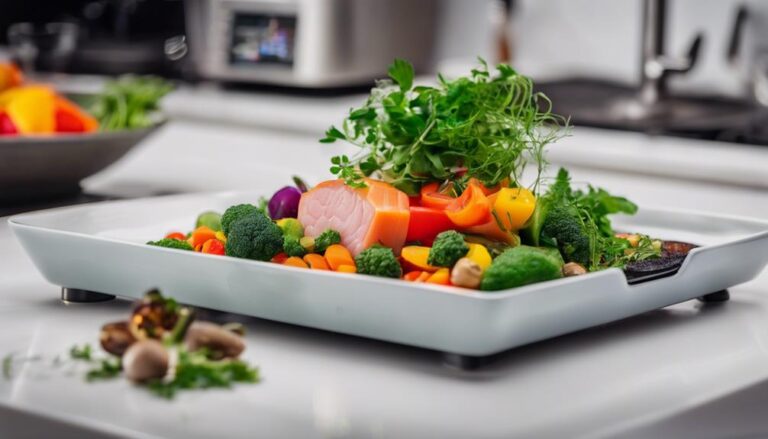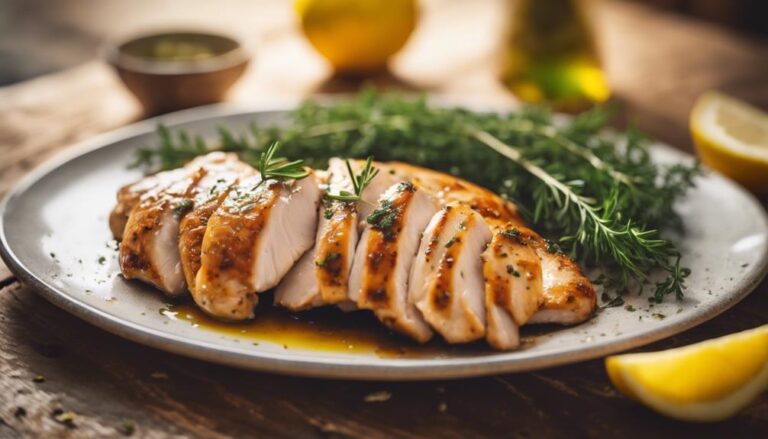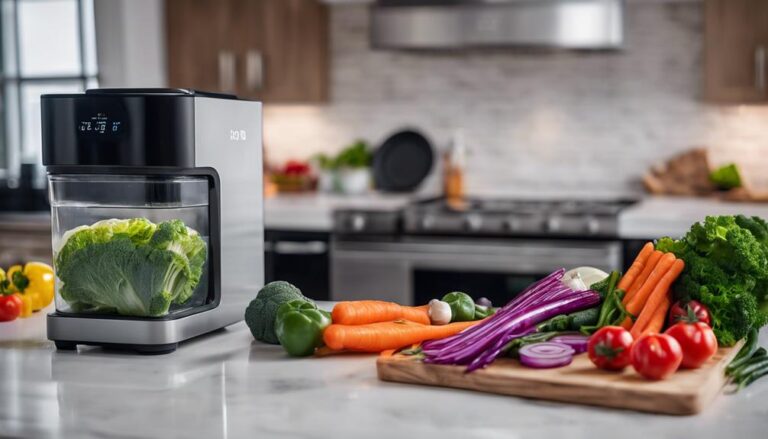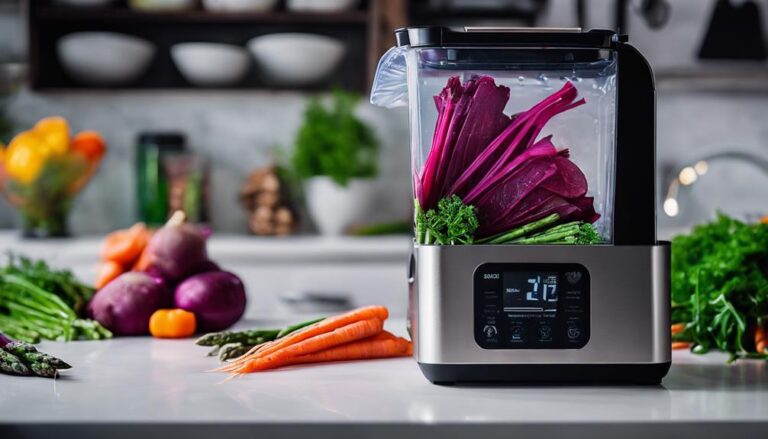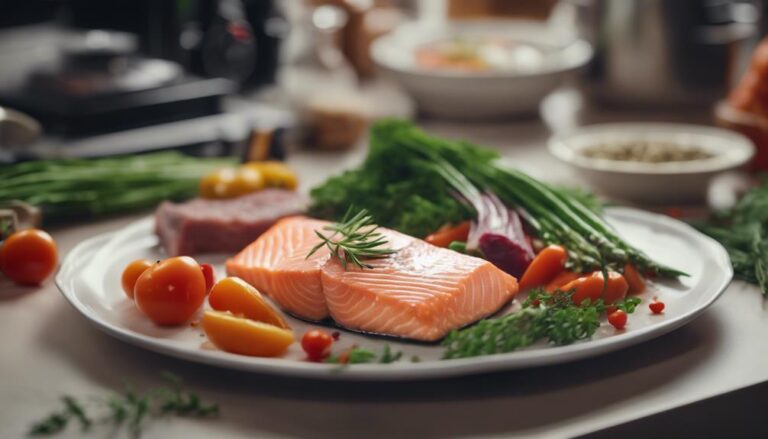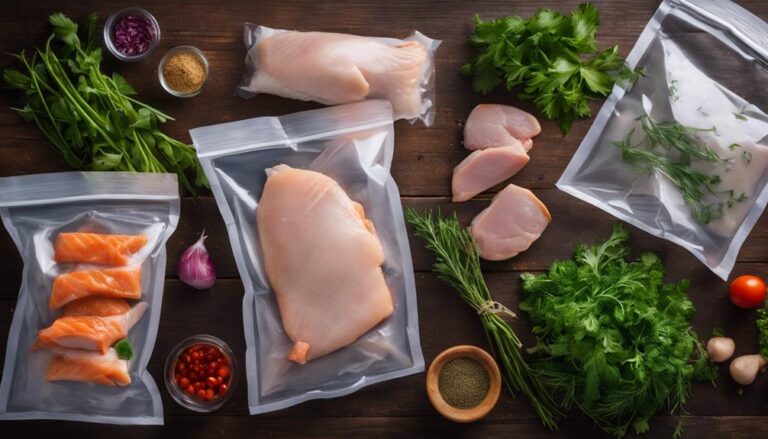The Best Sous Vide Recipes for Low-Sodium Diets
Sous vide cooking is a fantastic approach for crafting low-sodium meals. You can enhance natural flavors in proteins and vegetables without the need for added salt. Start your day with sous vide poached eggs or cheesy egg bites, then enjoy juicy chicken or flaky salmon for lunch or dinner. Vegetables like carrots and asparagus also shine when cooked sous vide, producing vibrant flavors. For heartier options, consider tender pork or beef prepared with fresh herbs and spices. This method simplifies meal prep and guarantees you enjoy healthy dishes throughout the week. There's much more to explore with these techniques.
What You Will Learn Here
- Sous vide cooking enhances natural flavors of proteins and vegetables, making it ideal for low-sodium diets without sacrificing taste.
- Utilize low-sodium marinades with herbs, spices, and citrus to amplify flavor in chicken, pork, and seafood.
- Breakfast options like sous vide poached eggs and cheesy egg bites can be prepared in advance for quick, low-sodium meals.
- Cooking vegetables sous vide at precise temperatures retains nutrients and enhances flavors, using fresh herbs to replace added salt.
Sous Vide Cooking Basics
Sous vide cooking is a precise method that involves sealing your food in a vacuum bag and immersing it in a temperature-controlled water bath for perfectly cooked meals without the risk of overcooking. This technique is especially valuable for those following low-sodium diets, as it enhances the natural flavors of your ingredients without the need for added salt.
To get started, you'll need a sous vide immersion circulator and vacuum bags. Set your water bath to the desired temperature, which varies depending on the type of food. For instance, chicken breasts typically require about 1.5 to 2 hours at 140°F for ideal tenderness.
When you're ready to cook, consider marinating your proteins beforehand with herbs and spices. This not only infuses flavors but also complements the low-sodium approach. Since sous vide cooking retains nutrients and flavors remarkably well, you'll be able to serve dishes that are both delicious and health-conscious.
Experimenting with various marinades can elevate your meals, making them satisfying for your guests while adhering to their dietary needs. With sous vide cooking, you can truly impress others with every dish you serve.
Benefits of Low-Sodium Diets
Adopting a low-sodium diet can considerably lower your risk of hypertension and improve overall heart health. By reducing sodium intake, you can help manage blood pressure levels and decrease the likelihood of heart disease.
The American Heart Association suggests limiting sodium to 2,300 mg per day, with an ideal goal of 1,500 mg for most adults. This change can also alleviate symptoms of heart failure, as less sodium leads to reduced fluid retention and less strain on the heart.
Incorporating sous vide chicken and other lean proteins into your meals makes it easier to stick to a low-sodium diet. These foods are typically lower in sodium and can be seasoned with herbs and spices for added flavor without the salt.
A low-sodium diet encourages you to focus on whole foods, such as fruits and vegetables, which are essential for better nutrition and overall well-being. Additionally, studies show that reducing sodium can improve kidney function, lowering the risk of kidney disease.
Breakfast Sous Vide Recipes
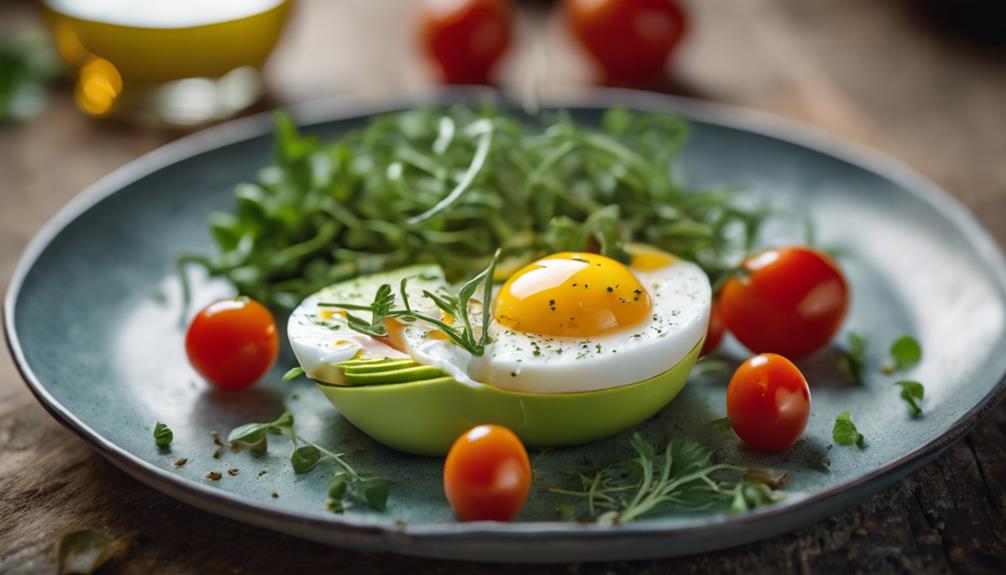
Start your day off right with delicious low-sodium breakfast options like sous vide poached eggs and cheesy sous vide egg bites. These meals not only taste fantastic but also support your dietary goals.
Sous vide poached eggs are a great choice, packed with high protein and choline, essential for brain function. Cooking them at around 165°F gives you that perfectly soft, custardy texture, making them a delightful addition to breakfast.
For a creamy, satisfying option, try cheesy sous vide egg bites. You can customize them using various low-sodium cheeses and fresh vegetables, ensuring they align with low-sodium diets. Preparing these egg bites in batches allows you to store them in the fridge, providing quick and convenient breakfasts throughout the week.
To enhance the flavors of your sous vide breakfast recipes, incorporate fresh herbs and spices. This approach elevates the taste without adding salt, making your meals flavorful and healthy.
Whether you're serving family or friends, these low-sodium breakfast options will impress while keeping everyone's health in mind. Enjoy the ease and satisfaction of sous vide cooking, and start your mornings with these tasty creations!
Chicken Recipes for Low Sodium
Cooking chicken sous vide offers a fantastic way to enjoy juicy, tender meat while keeping your sodium intake in check. This method allows you to achieve peak tenderness without relying heavily on salt.
You can experiment with low-sodium marinades that enhance flavor using fresh herbs like rosemary, thyme, and garlic. These ingredients not only provide delicious taste but also contribute to a healthier meal option for you and your guests.
To prepare sous vide chicken, set your water bath to 140°F and cook your chicken for 1.5 to 2 hours. This precise temperature guarantees that the chicken remains moist and flavorful. You can brighten the dish with citrus flavors, such as lemon juice, which adds a rejuvenating touch without increasing sodium levels.
One of the great advantages of sous vide chicken is that you can prepare it in bulk. This allows you to have healthy, low-sodium meals ready throughout the week, eliminating the need for high-sodium sauces.
Seafood Options in Sous Vide
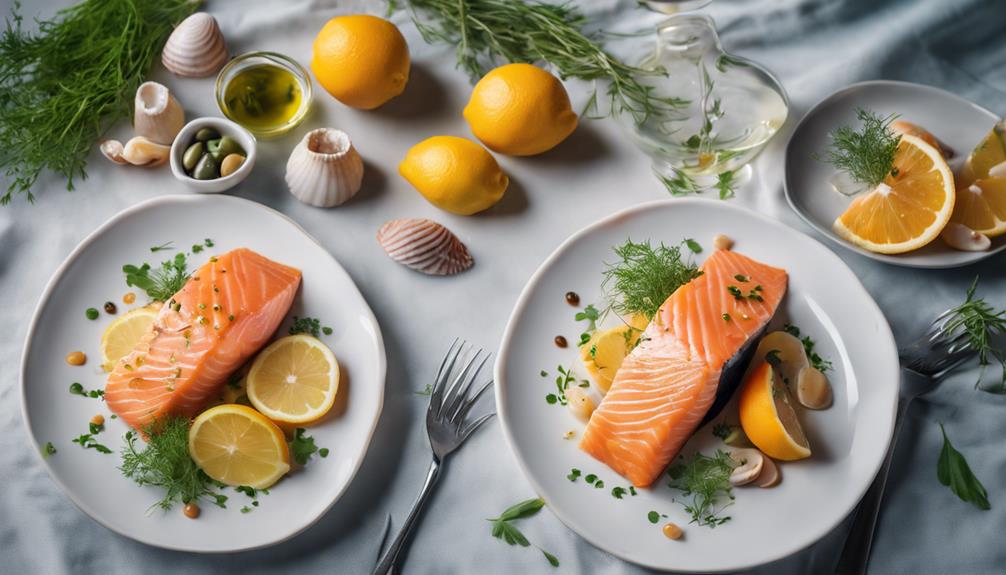
When you prepare seafood sous vide, you reveal a world of natural flavors and textures that require minimal salt for a delicious, low-sodium meal. One standout option is sous vide salmon, which cooks beautifully at 125°F. This method guarantees your salmon remains tender and flaky while retaining its moisture. You can enhance its flavor simply by adding herbs like rosemary or a squeeze of lemon, elevating your dish without the need for added salt.
Sous vide cooking also allows you to create a range of flavorful seafood dishes with a focus on marinades that include garlic, herbs, and citrus. These ingredients not only bring a delightful taste but also minimize sodium content, making them a great low-sodium option for family gatherings or dinner parties.
Additionally, the gentle sous vide process helps preserve the nutrient quality of your seafood, assuring you're serving a meal rich in omega-3 fatty acids and essential vitamins like B12 and D. By choosing sous vide for your seafood preparations, you can offer your guests satisfying, healthy, and flavorful dishes they'll love.
Flavorful Vegetable Dishes
Sous vide techniques not only enhance the flavors of seafood but also bring out the best in vegetables, allowing you to enjoy vibrant, low-sodium dishes. By cooking vegetables sous vide at 183°F for 90 minutes, you'll achieve perfectly tender textures and intensified flavors without the need for excess seasoning. This method helps retain the natural nutrients and flavors of your ingredients, making it perfect for low-sodium diets.
When preparing your vegetable dishes, consider popular options like asparagus, carrots, and bell peppers. You can vacuum-seal these veggies with a splash of lemon juice for added brightness and taste. To elevate the flavors further, use herbs and spices as flavorful substitutions for salt. Fresh herbs like rosemary, thyme, and basil can transform your dishes, providing depth without the sodium.
Sous vide cooking allows for precise temperature control, which means you can experiment with different cooking times and flavor combinations. This flexibility helps you create delicious vegetable dishes that will impress your guests while adhering to their dietary preferences. With these techniques, you can serve vibrant, low-sodium meals that everyone will enjoy.
Pork and Beef Sous Vide
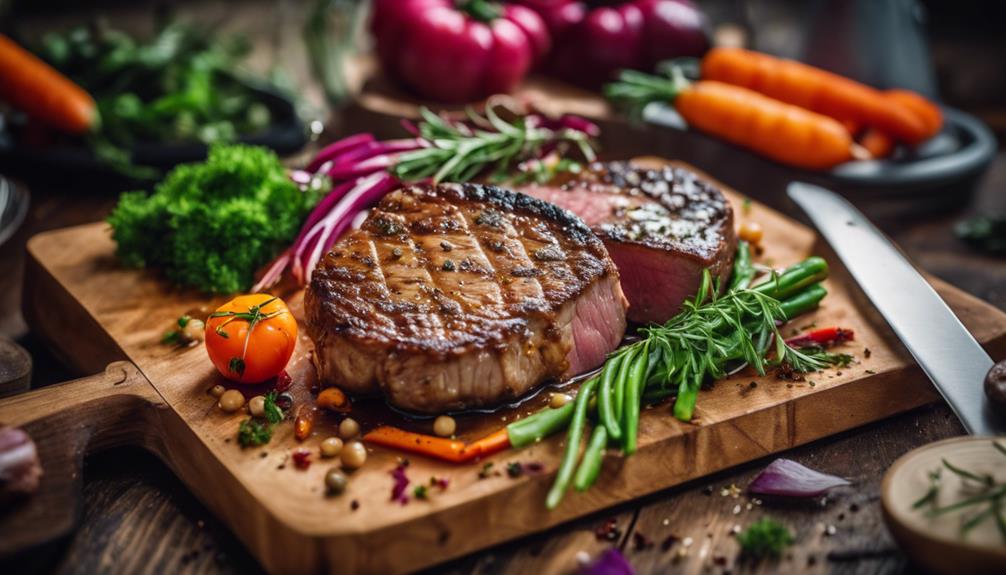
Achieving tender perfection in pork and beef is effortless with sous vide, allowing you to enjoy flavorful meats without the excess sodium. Here are three key benefits of using sous vide for your low-sodium diets:
- Precise Cooking: Sous vide lets you cook pork tenderloin and steak at exact temperatures, ensuring they're juicy and tender every time.
- Flavor Enhancement: You can use herbs and spices like rosemary, garlic, and thyme to season your meats, keeping sodium levels low while amplifying flavors.
- Versatile Techniques: Acid-based marinades, such as lemon juice or vinegar, can tenderize and flavor your pork and beef without relying on high-sodium ingredients.
For example, when cooking pork chops sous vide at 140°F for 1.5 to 2 hours, you achieve juicy meat that's perfect for serving guests.
Likewise, steak lovers can enjoy cuts like sirloin or ribeye cooked to their preference, whether medium-rare at 129°F or medium at 135°F.
With these sous vide recipes, you can impress your friends and family with delicious, low-sodium meals that prioritize health without sacrificing taste.
Meal Prep Ideas
Meal prepping with sous vide allows you to create flavorful, low-sodium dishes that are ready to enjoy any day of the week. This method enables you to prepare multiple servings of proteins, such as chicken or pork tenderloin, which can be vacuum-sealed and stored in the refrigerator or freezer. This way, you'll have quick, low-sodium meals at your fingertips, perfect for busy days.
When you're meal prepping sous vide, don't forget to incorporate vegetables. Cooking them at precise temperatures will help preserve their nutrients and enhance their natural flavors, making them delightful sides for your low-sodium diets.
You can also elevate the taste of your proteins by marinating them in low-sodium sauces or citrus-based mixtures. This not only adds flavor but keeps your meals interesting.
As you plan your meals, consider using fresh herbs and spices to season your dishes. These substitutes for salt will guarantee your meals are still vibrant and tasty.
Tips for Enhancing Flavor
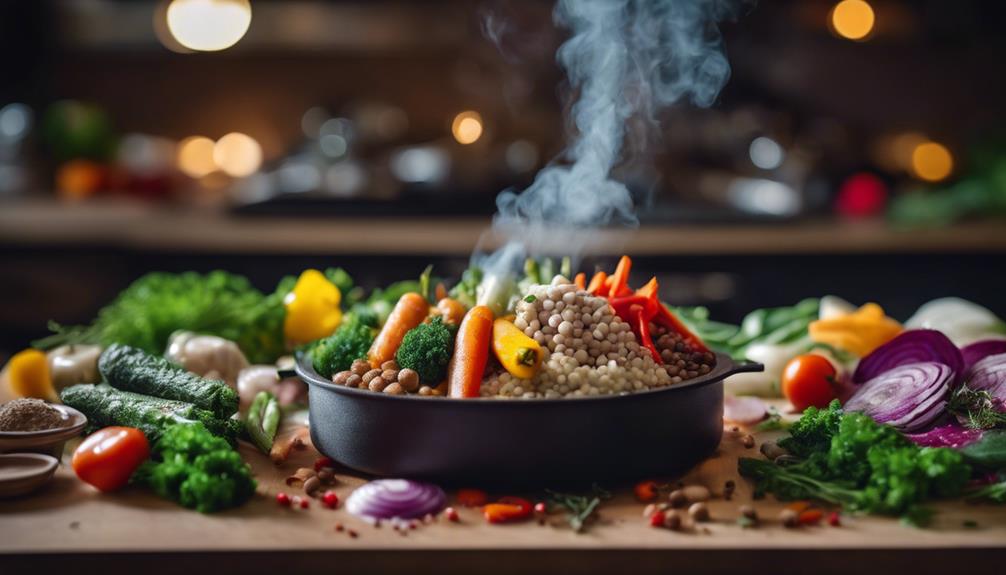
Releasing the full potential of your sous vide dishes means experimenting with herbs, spices, and other flavor-enhancing ingredients that keep sodium levels in check. Here are three effective strategies to elevate your meals:
- Utilize herbs and spices: Ingredients like garlic, rosemary, and chili powder can add vibrant flavors without increasing sodium. Experimenting with various combinations can surprise your guests.
- Incorporate acidic ingredients: Adding lemon juice, vinegar, or mustard can brighten flavors and provide a tangy contrast. These ingredients compensate for reduced salt, making your dishes more dynamic.
- Use umami-rich ingredients: Ingredients like mushrooms, nutritional yeast, or sun-dried tomatoes add depth and savoriness to your dishes. They enhance the overall taste while keeping sodium levels low.
Another helpful tip is to create a simple marinade using low-sodium options like yogurt or citrus-based mixtures. This infuses moisture and flavor without the need for salt.
Finally, searing your sous vide items in a small amount of olive oil post-cooking will create a flavorful crust, enhancing complexity without extra sodium.
With these tips, you can serve delicious meals that everyone will enjoy, all while adhering to a low-sodium diet.
Frequently Asked Questions
Is Sous Vide the Healthiest Way to Cook?
Is sous vide the healthiest way to cook? You'll find its benefits include superior nutrient retention and flavor enhancement. This technique allows you to serve meals that are both nutritious and delicious, impressing those you care for.
What Is the Best Thing to Make in a Sous Vide?
The best thing to make in a sous vide is chicken. You'll love its juicy texture and flavor enhancement. With cooking precision, meal prep becomes effortless, guaranteeing delicious results every time you serve your loved ones.
What Is the Best Protein to Sous Vide?
When you sous vide, consider chicken, salmon, or pork. Each offers unique protein textures, benefits from precise cooking times, and allows for flavor enhancement without extra salt, making them perfect for serving your guests delicious meals.
What Is the Best Meat to Cook Sous Vide?
When you explore sous vide techniques, focus on chicken, pork, steak, and salmon. Use meat marinades with herbs for flavor infusions, and pay attention to cooking times for perfectly tender results that impress your guests.
Conclusion
Incorporating sous vide cooking into your low-sodium diet can elevate your meals while keeping them healthy.
With a variety of recipes for breakfast, chicken, seafood, vegetables, pork, and beef, you'll find plenty of flavorful options.
Meal prepping with these techniques not only saves time but also allows you to control your sodium intake effectively.
By following the tips provided, you can enhance flavors without excessive salt, making your low-sodium meals both enjoyable and satisfying.






